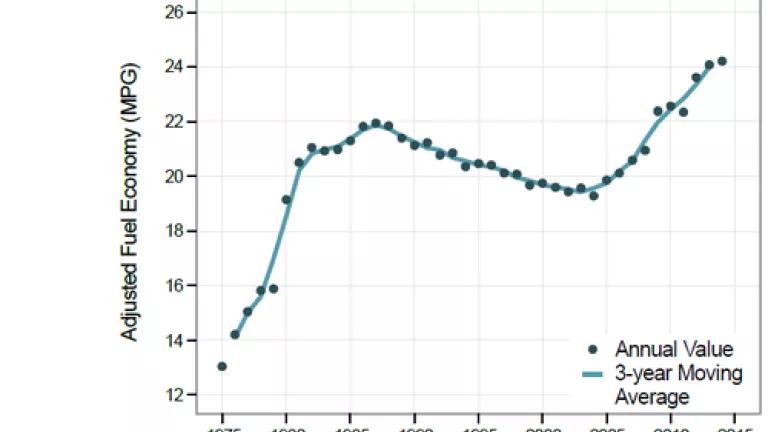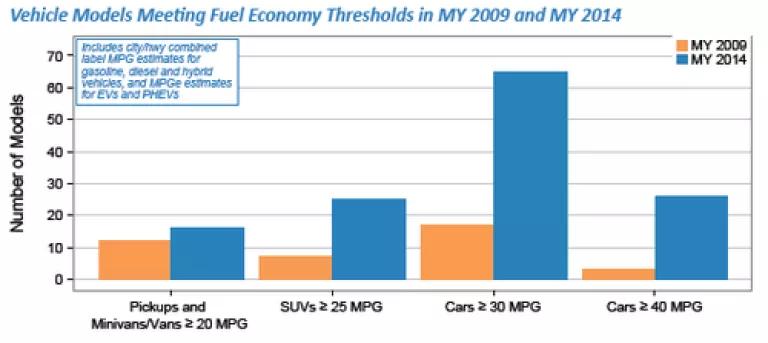
Part of NRDC’s Year-End Series Reviewing 2014 Clean Energy Developments
When it comes to automobiles, 2014 has been a year of good news for consumers, public health and the environment. Thanks to tightening standards, cars are more fuel efficient than ever. From vehicles powered by advanced combustion engines to those running on electric batteries, shoppers have a record number of choices in all sizes that save money on gas.
Record Fuel Economy
New automobiles are at record-high fuel economy levels reaching 24.1 miles per gallon (mpg) on average for model year 2013, according to the latest figures from the Environmental Protection Agency. Importantly, new cars also have the lowest average carbon pollution level, which helps the fight against climate change. Compared to 2008 vehicles, today’s new cars will keep more than 90 million tons carbon pollution out of the air while saving individual drivers hundreds of dollars each year at the pump.
Credit: EPA Fuel Economy Trends: 1975 Through 2014
Federal clean car and fuel economy standards, which ramp up to the equivalent of 54.5 mpg in 2025, are reducing the U.S. thirst for gasoline, which dropped about 1.3 percent in the first 9 months of 2014 compared to the same period in 2013. The Energy Information Administration projects gasoline demand will continue to drop by about 1.4 percent in 2015 despite an increase in personal vehicle travel of about 0.5 percent.
Automakers are investing in fuel saving technologies across their fleets, from pickups and SUVs to cars.

Credit: EPA Fuel Economy Trends: 1975 Through 2014
We can expect gasoline vehicles to continue to improve with expanded use of turbo-charged direct-injection engines, eight- or more speed transmissions, idle stop-start systems and lighter materials.
Charging Ahead with Electric Vehicles
To meet long-term pollution reduction goals that protect our climate and air quality, our nation’s automobile fleet must transition from oil to clean power sources like renewable electricity from the sun and wind. Advances this year show we’re on the right track.
In 2014, more than 107,000 plug-in electric vehicles were sold, bringing the national plug-in electric fleet to over 275,000. It’s a big jump from almost zero in 2010 but we have long way to go. It will take years to turn over the on-road gasoline fleet of 230 million cars, but several states have recognized that it’s time to put vehicle electrification in the fast lane.
This year also marked an unprecedented state commitment to accelerating the market for plug-in electric vehicles (EVs) with passage of the Charge Ahead California Initiative to put 1 million EVs on the road within 10 years. It creates new financing mechanisms and other programs with specific attention to disadvantaged communities. As my colleague Max Baumhefner describes “the legislation is the first in the nation to promote the use of electric cars, trucks, and buses on California’s streets and ensure that communities that have suffered for too long from dangerous air pollution share in the benefits of a shift away from oil.”
States in the Northeast and Northwest have joined California in a commitment to put 3.3 million plug-in or fuel-cell electric vehicles on their roads by 2025. In 2014, eight states, including California, Connecticut, Maryland, Massachusetts, New York, Oregon, Rhode Island and Vermont, developed a Multi-State Zero Emission Vehicle (ZEV) Action Plan to power up the electric-drive market. Today, these eight states represent about 25 percent of the new car market but also half of EV market. Their planned actions could serve as a tipping point for electric cars to really zip into the market nationwide.
Breathing Easier: Tier 3 Standards Cut Smog and Soot Pollution
In its 2014 State of the Air report, the American Lung Association found that over 147 million Americans live in areas where ozone—the principal component of smog—and soot levels are “too often dangerous to breathe.” Vehicles are a significant source of those pollutants, which are linked to asthma attacks, impaired cardiovascular function, and even premature deaths.
In February, the Environmental Protection Agency tightened standards on gasoline and new automobiles to clean up their tailpipes beginning in 2017. These “Tier 3” standards will cut gasoline sulfur by two-thirds. The cleaner gasoline will have the immediate effect of reducing smog-forming pollutants from existing vehicles because lower sulfur allows exhaust systems to be more effective. It will be roughly equivalent to replacing 30 million of today’s cars with zero-emitting vehicles.
Lower sulfur also enables tighter exhaust standards for new automobiles made after 2016. When fully implemented in 2025, the average new vehicle will reduce smog- and soot-forming emissions of nitrogen oxides, volatile organic compounds, and fine particulate matter by 70 to 80 percent compared today’s vehicles.
Making cleaner gasoline is expected to cost only about a penny a gallon but Americans can expect to save $7 to $19 billion annually in avoided health care costs. The oil industry—always focused on protecting already huge profits—fought the standards but smart policy and public opinion won. Millions of Americans will be able to breathe easier.
Looking Ahead
This year was marked by many strong steps toward a cleaner, less oil-dependent transportation system. But there’s much more to be done in 2015. It should be a New Year’s resolution of the Obama administration to set strong fuel efficiency standards on medium- and heavy-duty trucks, which have the potential to reduce their fuel consumption by at least 40 percent, cutting pollution and saving truckers money. We need to continue to build upon our strong record of vehicle emissions and efficiency standards, making 2015 an even better year for cars and trucks—and the good for the environment, public health and the economy.

